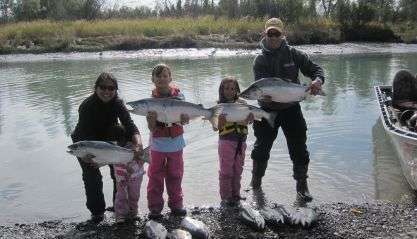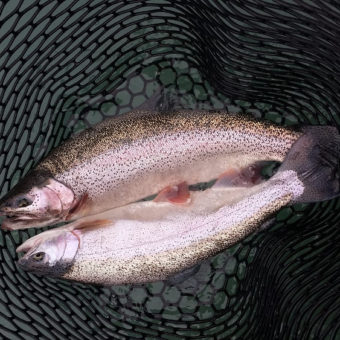Here’s some helpful tips on how to handle your fish…
Catch and release, or catch and kill, there’s a right and a wrong way to treat fish. After all, there’s no point to killing a fish if it will never make it to the dinner table. And why let a fish go if it’s going to die. These are two very important questions that each and every sport angler must ask.
When you tell people you released your trophy, some may ask,”You did what!?…,” or, “What’s the point of catching a fish if you’re just going to let it go? ” My own personal favorite is, “You let it go!, why?, I would have taken it!” Hearing this stuff is hard to understand for serious sport anglers but it is important to remember that not everyone wets a line for the same reason(s).
The idea that releasing a wild creature to live another day is one of the most empowering sportfishing accomplishments an angler can experience, is still far from a majority opinion. Speaking specifically of wild salmon and steelhead stocks, there’s very few river systems in the lower forty eight and also Alaska that can continue to support a “harvest” fishery. Reduced limits, fishing restrictions, and mandatory catch and release, are all precedents of our collective angling future and understanding the importance of proper fish handling and release procedures, is integral to the sustained health of increasingly popular fisheries.
Before exploring the proper way to treat the fish you intend to release, let’s first cover the best way to preserve those fish you intend to eat. In Alaska, most wild salmon stocks are healthy enough to support a harvest fishery, and most people that fish for Alaskan salmon do so with the intention of taking this delectable meat home.
Proper care for your catch in the field will go along way toward ensuring it tastes good and fresh when it eventually gets to the dinner table. Contrary to popular practice, keeping a fish alive on a stringer is not a good idea. You should kill your catch quickly with a sharp rap on top of the head. Blood in the meat of your fish will greatly effect the freshness of its taste so bleeding your catch by cutting the main artery to their gills is essential. As much as possible, it’s also a good idea to avoid letting your fish lie in water, blood or slime after cleaning. However, if you plan to continue fishing for some time, uncleanned fish can be kept cool in the river while you complete your limit. Once you’re done fishing it’s always a good idea to cover your cleaned fish with ice to keep them cool in transport to the processor (or your own freezer). Avoid throwing or dropping your fish as this can cause the meat to bruise. Particularly with salmon, filleting and vacuum sealing your catch in 1-2 lb. portions seems to work best. Vacuum sealing and freezing your catch will go along way toward preventing spoilage. (Unbroken, vacuum sealed packages will preserve your fish in the freezer for up to a year without effecting overall freshness). Last but not least, you should only keep the fish you need. A freezer full of old fish is a sure way to upset the “fish gods” and make your next fishing trip an unlucky affair.
Now that we’ve covered the basics of preserving your catch for the dinner table, lets look at the proper etiquette for releasing fish. A recent study done at Queens University in Ontario, Canada which looked at physiological effects of brief air exposure in exhaustively exercised (played out) rainbow trout (oncorhynchus mykiss), is very revealing and educational toward showing just how precarious and detrimental, improper catch and releasing fishing can be. I will be the first to say that even as a professional fishing guide and well accomplished recreational sportfisherman, I did not know all the facts when it comes to releasing the quarry of my angling efforts.
I will attempt to share with you the most scientifically substantiated information I have seen on catch and release methods. The study looked at survival rates of played out rainbow trout that were also exposed to air for 60 seconds, 30 seconds, and 0 seconds. Additionally, the survival rates on non-exercised rainbow trout were used as a control for the study. Get ready, the results are surprising.
As you’d expect, the control group had a 100% survival rate. The rainbow trout that were exhaustively exercised and not exposed to air survived at an 88% rate. However, the rate of survival for fish exposed to air for 30 seconds was only 62%, and those that were held out of the water for 60 seconds had a mere 28% chance of living to fight another day. The researchers attributed the higher mortality among fish exposed to air to a significant reduction of oxygen content in the fish’s blood.
If these statistics leave you wondering or unconvinced, consider the following analogy: Holding a fish out of the water for 60 seconds or even 30 seconds would be like a human running full speed for a half an hour and then immediately being submerged in water for up to one full minute. Many of us would not fare very well under those conditions and if we did survive, we’d surely carry some ill effects, some possibly permanent.
This study will change the pace of my Kodak moment and expedite the time it takes me to put my catch back into the water. Ideally, keeping the fish submerged in the water while you take pictures will help tremendously toward making sure the fish doesn’t eventually go belly up.
Some other important methods for handling fish you intend to release include touching the fish as little as possible, not squeezing the fish, and never putting your fingers inside the fish’s gills. The more you handle a fish and run your hand(s) along its sides, the more that fish is likely to be depleted of its protective slime layer, thus increasing its risk of fungal infection and decreasing its ability to gracefully cut through the water. See also the article on how to release fish.
I like to run my hand along the leader to the fish’s mouth and grasp the hook firmly until I can pinch it with a pair of pliers, using the weight of the fish to pull it loose. A lot of times (unless the hook is in an awkward position) I don’t even touch the fish at all. When you hold a fish by squeezing it in the palm of your hand, you are not only removing its protective slime, but also possibly injuring its internal organs.
Equally important and potentially life-threatening to the fish is putting your finger(s) in their gills. A fish’s gills are among their most fragile and crucial organs. Evolution has provided them protective gill plates to prevent anything from entering or piercing this fragile area. But unknowing anglers will routinely use this gill plate to hold their catch and although this is fine when you intend to keep the fish, it’s a bad deal if a release is planned.

















































